Toyota RAV4: Using the audio system
Audio system types
Without Display Audio system
CD player and AM/FM radio
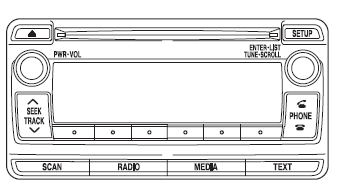
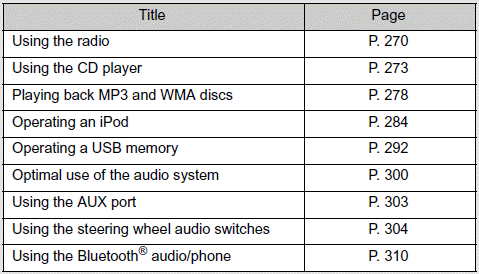
With Display Audio system
Owners of models equipped with a Display Audio system should refer to the “Display Audio System Owner's Manual”.
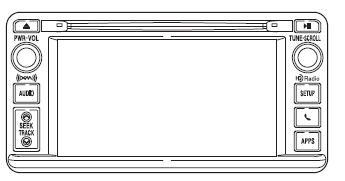
■Using cellular phones
Interference may be heard through the audio system's speakers if a cellular phone is being used inside or close to the vehicle while the audio system is operating.
■About Bluetooth
The Bluetooth wordmark and logo are owned by Bluetooth SIG. and permission has been granted to use the trademark of the licensee Panasonic Corporation. Other trademarks and trade names are owned by various different owners.
■Trademark owned by SRS Labs, Inc. (with Display Audio system)

The audio systems utilize SRS FOCUS® and SRS TruBass® audio enhancement technologies, under license from SRS Labs, Inc., in all modes except AM radio mode.
FOCUS, TruBass, SRS and  symbol are
trademarks of SRS Labs, Inc.
FOCUS and TruBass technologies are incorporated under license from
SRS Labs, Inc.
TruBass® enhances the perception of bass frequencies to provide deep, rich
bass response from any size speaker.
SRS FOCUS® raises the audio image from non-optimally placed speakers
up to the natural listening height at ear level.
symbol are
trademarks of SRS Labs, Inc.
FOCUS and TruBass technologies are incorporated under license from
SRS Labs, Inc.
TruBass® enhances the perception of bass frequencies to provide deep, rich
bass response from any size speaker.
SRS FOCUS® raises the audio image from non-optimally placed speakers
up to the natural listening height at ear level.
CAUTION
■U.S.A. (without Display Audio system)
FCC ID: ACJ932PTA184
FCC WARNING
Changes or modifications not expressly approved by the party responsible
for compliance could void the user's authority to operate the equipment.
This transmitter must not be co-located or operated in conjunction with any
other antenna or transmitter.
This equipment complies with FCC radiation exposure limits set forth for an
uncontrolled environment and meets the FCC radio frequency (RF) Exposure
Guidelines in Supplement C to OET65. This equipment has very low
levels of RF energy that it deemed to comply without maximum permissive
exposure evaluation (MPE). But it is desirable that it should be installed and
operated keeping the radiator at least 20cm or more away from person's
body (excluding extremities: hands, wrists, feet and ankles).
●Laser products
• Do not take this unit apart or attempt to make any changes yourself.
This is an intricate unit that uses a laser pickup to retrieve information
from the surface of compact discs.
The laser is carefully shielded so that its rays remain inside the cabinet.
Therefore, never try to disassemble the player or alter any of its parts
since you may be exposed to laser rays and dangerous voltages.
• This product utilizes a laser.
Use of controls or adjustments or performance of procedures other
than those specified herein may result in hazardous radiation exposure.
• The use of optical instruments with this product will increase eye hazard.
■Canada (without Display Audio system)
This device complies with Industry Canada licence-exempt RSS standard(
s).
Operation is subject to the following two conditions:
(1) this device may not cause interference, and
(2) this device must accept any interference, including interference that may
cause undesired operation of the device.
Le présent appareil est conforme aux CNR d'Industrie Canada applicables
aux appareils radio exempts de licence.
L'exploitation est autorisée aux deux conditions suivantes: (1) l'appareil ne
doit pas produire de brouillage, et (2) l'utilisateur de l'appareil doit
accepter
tout brouillage radioélectrique subi, même si le brouillage est susceptible
d'en compromettre le fonctionnement.
Under Industry Canada regulations, this radio transmitter may only operate
using an antenna of a type and maximum (or lesser) gain approved for the
transmitter by Industry Canada. To reduce potential radio interference to
other users, the antenna type and its gain should be so chosen that the
equivalent isotropically radiated power (e.i.r.p.) is not more than that
necessary
for successful communication.
Conformément à la réglementation d'Industrie Canada, le présent émetteur radio peut fonctionner avec une antenne d'un type et d'un gain maximal (ou inférieur) approuvé pour l'émetteur par Industrie Canada. Dans le but de réduire les risques de brouillage radioélectrique à l'intention des autres utilisateurs, il faut choisir le type d'antenne et son gain de sorte que la puissance isotrope rayonnée équivalente (p.i.r.e.) ne dépasse pas l'intensité nécessaire à l'établissement d'une communication satisfaisante. This equipment complies with IC radiation exposure limits set forth for an uncontrolled environment and meets RSS-102 of the IC radio frequency (RF) Exposure rules. This equipment has very low levels of RF energy that it deemed to comply without maximum permissive exposure evaluation (MPE). But it is desirable that it should be installed and operated keeping the radiator at least 20cm or more away from person's body (excluding extremities:
hands, wrists, feet and ankles). Cet équipement est conforme aux limites d’exposition aux rayonnements énoncées pour un environnement non contrôlé et respecte les règles d’exposition aux fréquences radioélectriques (RF) CNR-102 de l’IC. Cet équipement émet une énergie RF très faible qui est considérée conforme sans évaluation de l’exposition maximale autorisée. Cependant, cet équipement doit être installé et utilisé en gardant une distance de 20 cm ou plus entre le dispositif rayonnant et le corps (à l’exception des extrémités : mains, poignets, pieds et chevilles).
■U.S.A. (with Display Audio system)
FCC ID: AJDK032
This device complies with Part 15 of FCC Rules and Industry Canada
licence-exempt RSS standard(s).
Operation is subject to the following two conditions:
(1) this device may not cause interference, and
(2) this device must accept any interference, including interference that may
cause undesired operation of this device.
The antenna for Bluetooth cannot be removed (or replaced) by user.
This device complies with RSS-310 of Industry Canada. Operation is subject
to the condition that this device does not cause harmful interference.
FCC Warning:
Changes or modifications not expressly approved by the party responsible
for compliance could void the user’s authority to operate the equipment.
This equipment complies with FCC/IC radiation exposure limits set forth for
an uncontrolled environment and meets the FCC radio frequency (RF) Exposure
Guidelines in Supplement C to OET65 and RSS-102 of the IC radio frequency
(RF) Exposure rules. This equipment has very low levels of RF
energy that it deemed to comply without maximum permissive exposure
evaluation (MPE). But it is desirable that it should be installed and operated
keeping the radiator at least 20cm or more away from person’s body
(excluding extremities: hands, wrists, feet and ankles).
NOTE: This equipment has been tested and found to comply with the limits
for a Class B digital device, pursuant to Part 15 of the FCC Rules. These limits
are designed to provide reasonable protection against harmful interference
in a residential installation. This equipment generates, uses and can
radiate radio frequency energy and, if not installed and used in accordance
with the instructions, may cause harmful interference to radio communications.
However, there is no guarantee that interference will not occur in a
particular installation.
If this equipment does cause harmful interference to radio or television
reception, which can be determined by turning the equipment off and on, the
user is encouraged to try to correct the interference by one or more of the
following measures:
- Reorient or relocate the receiving antenna.
- Increase the separation between the equipment and receiver.
- Connect the equipment into an outlet on a circuit different from that to
which the receiver is connected.
- Consult the dealer or an experienced radio/TV technician for help.
This transmitter must not be co-located or operated in conjunction with any
other antenna or transmitter.
■Canada (with Display Audio system)
IC ID: 775E-K032
This device complies with Part 15 of FCC Rules and Industry Canada
licence-exempt RSS standard(s).
Operation is subject to the following two conditions:
(1) this device may not cause interference, and
(2) this device must accept any interference, including interference that may
cause undesired operation of this device.
Le présent appareil est conforme aux la partie 15 des règles de la FCC et
CNR d’Industrie Canada applicables aux appareils radio exempts de
licence.
L’exploitation est autorisée aux deux conditions suivantes:
(1) l’appareil ne doit pas produire de brouillage, et
(2) l’utilisateur de l’appareil doit accepter tout brouillage radioélectrique
subi,
même si le brouillage est susceptible d’en compromettre le
fonctionnement.
The antenna for Bluetooth cannot be removed (or replaced) by user.
L’antenne de Bluetooth ne peut pas être supprimé (ou remplacé) par
l’utilisateur.
This device complies with RSS-310 of Industry Canada. Operation is subject
to the condition that this device does not cause harmful interference.
Cet appareil est conforme au CNR-310 d’Industrie Canada. Son exploitation
est autorisée sous réserve que l’appareil ne cause pas de brouillage
préjudiciable.
FCC Warning:
Changes or modifications not expressly approved by the party responsible
for compliance could void the user's authority to operate the equipment.
This equipment complies with FCC/IC radiation exposure limits set forth for
an uncontrolled environment and meets the FCC radio frequency (RF) Exposure
Guidelines in Supplement C to OET65 and RSS-102 of the IC radio frequency
(RF) Exposure rules. This equipment has very low levels of RF
energy that it deemed to comply without maximum permissive exposure
evaluation (MPE). But it is desirable that it should be installed and operated
keeping the radiator at least 20cm or more away from person’s body
(excluding extremities: hands, wrists, feet and ankles).
Cet équipement est conforme aux limites d’exposition aux rayonnements
énoncées pour un environnement non contrôlé et respecte les règles les
radioélectriques (RF) de la FCC lignes directrices d'exposition dans le
Supplément C à OET65 et d’exposition aux fréquences radioélectriques
(RF) CNR-102 de l’IC. Cet équipement émet une énergie RF très faible qui
est considérée conforme sans évaluation de l’exposition maximale
autorisée. Cependant, cet équipement doit être installé et utilisé en gardant
une distance de 20 cm ou plus entre le dispositif rayonnant et le corps (à
l’exception des extrémités : mains, poignets, pieds et chevilles).
NOTE: This equipment has been tested and found to comply with the limits
for a Class B digital device, pursuant to Part 15 of the FCC Rules. These limits
are designed to provide reasonable protection against harmful interference
in a residential installation. This equipment generates, uses and can
radiate radio frequency energy and, if not installed and used in accordance
with the instructions, may cause harmful interference to radio communications.
However, there is no guarantee that interference will not occur in a
particular installation.
If this equipment does cause harmful interference to radio or television reception, which can be determined by turning the equipment off and on, the user is encouraged to try to correct the interference by one or more of the following measures:
- Reorient or relocate the receiving antenna.
- Increase the separation between the equipment and receiver.
- Connect the equipment into an outlet on a circuit different from that to
which the receiver is connected.
- Consult the dealer or an experienced radio/TV technician for help.
This transmitter must not be co-located or operated in conjunction with any
other antenna or transmitter.
NOTICE
■To prevent battery discharge
Do not leave the audio system on longer than necessary when the engine is
off.
■To avoid damaging the audio system
Take care not to spill drinks or other fluids over the audio system.
Using the radio
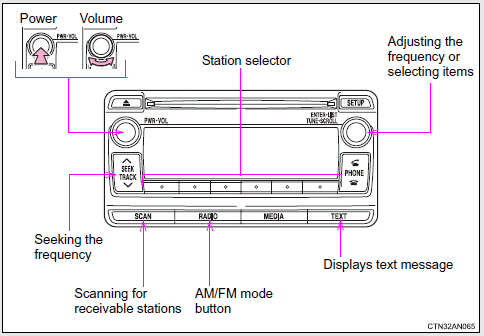
Setting station presets
1 Search for desired stations by turning
 or pressing “∧”
or “∨” on
or pressing “∧”
or “∨” on  .
.
2 Press and hold the button (from  ) until you
hear a beep.
) until you
hear a beep.
Scanning radio stations
■ Scanning the preset radio stations
1 Press and hold until you hear a
beep.
until you hear a
beep.
Preset stations will be played for 5 seconds each.
2 When the desired station is reached, press
 once
again.
once
again.
■ Scanning all radio stations within range
1 Press 
All stations with reception will be played for 5 seconds each.
2 When the desired station is reached, press
 once
again.
once
again.
Switching the display
Press  .
.
If the text continues past the end of the display, “
 ” is displayed. Press
” is displayed. Press
 .
.
■Reception sensitivity
●Maintaining perfect radio reception at all times is difficult due to the
continually
changing position of the antenna, differences in signal strength
and surrounding objects, such as trains and transmitters.
●The radio antenna is mounted on the rear roof. The antenna can be
removed from the base by turning it.
■Certifications for the radio tuner
This equipment has been tested and found to comply with the limits for a class B digital device, pursuant to Part 15 of the FCC Rules. These limits are designed to provide reasonable protection against harmful interference in a residential installation. This equipment generates, uses and can radiate radio frequency energy and, if not installed and used in accordance with the instructions, may cause harmful interference to radio communications. However, there is no guarantee that interference will not occur in a particular installation. If this equipment does cause harmful interference to radio or television reception, which can be determined by turning the equipment off and on, the user is encouraged to try to correct the interference by trying one or more of the following:
●Reorienting or relocating the receiving antenna.
●Increasing the separation between the equipment and receiver.
●Connecting the equipment into an outlet on a circuit different from that to
which the receiver is connected.
●Consulting the dealer or an experienced radio/TV technician for help.
NOTICE
■To prevent damage, remove the antenna in the following cases.
●The antenna will touch the ceiling of a garage.
●A cover will be put on the roof.
Using the CD player
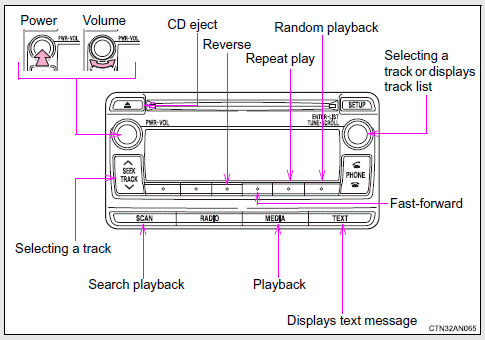
Loading CDs
Insert a CD.
Ejecting CDs
Press  and remove the CD.
and remove the CD.
Selecting a track
Turn  or press “∧” to move up or
“∨” to move down using
or press “∧” to move up or
“∨” to move down using  until the
desired track number is displayed.
until the
desired track number is displayed.
Fast-forwarding and reversing tracks
To fast-forward or reverse, press 
Selecting a track from a track list
1 Press  .
.
The track list will be displayed.
2 Turn and press  to select
a track.
to select
a track.
To return to the previous display, press
 (BACK).
(BACK).
Scanning tracks
1 Press  .
.
The first 10 seconds of each track will be played.
2 Press  again when the desired
track is reached.
again when the desired
track is reached.
Random playback
■ Current CD
Press  (RDM).
(RDM).
To cancel, press the button once more.
Repeat play
Press  (RPT).
(RPT).
To cancel, press the button once more.
Switching the display
Press  .
.
Track title, Artist name and Disc title are shown on the display.
To return to the previous display, press
 or
or
 (BACK).
(BACK).
■Display
Up to 12 characters can be displayed at a time.
If there are 13 characters or more, pressing and holding
 for 1
second or more will display the remaining characters.
A maximum of 64 characters can be displayed.
for 1
second or more will display the remaining characters.
A maximum of 64 characters can be displayed.
If  is pressed for 1 second or
more again, or has not been pressed
for 6 seconds or more, the display will return to the first 12 characters.
Depending on the contents recorded, the characters may not be displayed
properly or may not be displayed at all.
is pressed for 1 second or
more again, or has not been pressed
for 6 seconds or more, the display will return to the first 12 characters.
Depending on the contents recorded, the characters may not be displayed
properly or may not be displayed at all.
■Error messages
“ERROR”: This indicates a problem either in the CD or inside the player.
“CD CHECK”: The CD may be dirty, damaged or inserted up-side down.
“WAIT”: Operation has stopped due to a high temperature inside the
player. Wait for a while and then press
 . If the CD
still cannot be played back, contact your Toyota dealer.
. If the CD
still cannot be played back, contact your Toyota dealer.
■Discs that can be used
Discs with the marks shown below can be used. Playback may not be possible depending on recording format or disc features, or due to scratches, dirt or deterioration.

CDs with copy-protect features may not be used.
■CD player protection feature
To protect the internal components, playback is automatically stopped when a problem is detected while the CD player is being used.
■If a CD is left inside the CD player or in the ejected position for extended periods
CDs may be damaged and may not play properly
■Lens cleaners
Do not use lens cleaners. Doing so may damage the CD player.
NOTICE
■CDs and adapters that cannot be used
Do not use the following types of CDs or 3 in. (8 cm) CD adapters or Dual
Disc.
Doing so may damage the CD player and/or the CD insert/eject function.
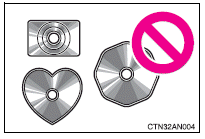 ●CDs that have a diameter that is not 4.7
in. (12 cm)
●CDs that have a diameter that is not 4.7
in. (12 cm)
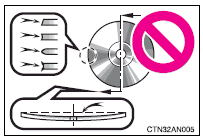
●Low-quality and deformed CDs
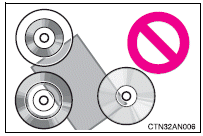
●CDs with a transparent or translucent recording area
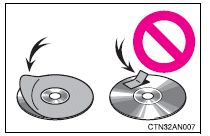
●CDs that have had tape, stickers or CDR labels attached to them, or that have had the label peeled off
■CD player precautions
Failure to follow the precautions below may result in serious damage to the CDs or the player itself.
●Do not insert anything other than CDs into the CD slot.
●Do not apply oil to the CD player.
●Store CDs away from direct sunlight.
●Never try to disassemble any part of the CD player.
Playing back MP3 and WMA discs
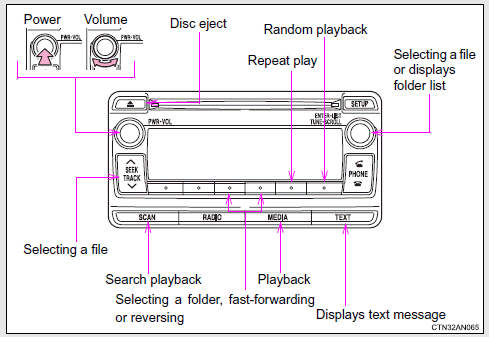
Selecting and scanning a folder
■ Selecting folders one at a time
Press  ( < ) or
( < ) or
 ( > ) to select the desired folder.
( > ) to select the desired folder.
■ Selecting a folder and file from folder list
1 Press  .
.
The folder list will be displayed.
2 Turn and press  to select a
folder and a file.
to select a
folder and a file.
To return to the previous display, press
 (BACK).
(BACK).
■ Returning to the first folder
Press and hold  ( < ) until you
hear a beep.
( < ) until you
hear a beep.
■ Scanning a folder
1 Press and hold  until you hear
a beep.
until you hear
a beep.
The first 10 seconds of the first file in the each folder will be played.
2 When the desired folder is reached, press
 again.
again.
Selecting and scanning files
■ Selecting one file at a time
Turn or press “∧” or “∨” on
or press “∧” or “∨” on
 to select the desired file.
to select the desired file.
■ Selecting the desired file by cueing the files in the folder
Press 
When the desired file is reached, press
 once again.
once again.
Random playback
Pressing  (RDM) changes modes in
the following order:
(RDM) changes modes in
the following order:
Folder random → Disc random → Off
Repeat play
Pressing  (RPT) changes modes in
the following order:
(RPT) changes modes in
the following order:
File repeat → Folder repeat* → Off
*: Available except when RDM (random playback) is selected
Switching the display
Press  .
.
Track title, Artist name and Album title (MP3 only) are shown on the display.
To return to the previous display, press
 or
or
 (BACK).
(BACK).
■Error messages
“CD CHECK”: This indicates a problem either in the CD or inside the player. The CD may be dirty, damaged or inserted up-side down. “ERROR”: This indicates a problem either in the CD or inside the player. “NO SUPPORT”: This indicates that the MP3/WMA file is not included in the CD.
■MP3 and WMA files
MP3 (MPEG Audio LAYER3) is a standard audio compression format. Files can be compressed to approximately 1/10 of their original size by using MP3 compression. WMA (Windows Media Audio) is a Microsoft audio compression format. This format compresses audio data to a size smaller than that of the MP3 format. There is a limit to the MP3 and WMA file standards that can be used and to the media/formats on which the files are recorded.
●MP3 file compatibility
• Compatible standards
MP3 (MPEG1 LAYER3, MPEG2 LSF LAYER3)
• Compatible sampling frequencies
MPEG1 LAYER3: 32, 44.1, 48 (kHz)
MPEG2 LSF LAYER3: 16, 22.05, 24 (kHz)
• Compatible bit rates (compatible with VBR)
MPEG1 LAYER3: 32, 40, 48, 56, 64, 80, 96, 112, 128, 160, 192, 224,
256, 320 (kbps)
MPEG2 LSF LAYER3: 8, 16, 24, 32, 40, 48, 56, 64, 80, 96, 112, 128,
144, 160 (kbps)
• Compatible channel modes: stereo, joint stereo, dual channel and
monaural
●WMA file compatibility
• Compatible standards
WMA Ver. 7, 8, 9
• Compatible sampling frequencies
32, 44.1, 48 (kHz)
• Compatible bit rates (only compatible with 2-channel playback)
Ver. 7, 8: CBR 48, 64, 80, 96, 128, 160, 192 (kbps)
Ver. 9: CBR 48, 64, 80, 96, 128, 160, 192, 256, 320 (kbps)
●Compatible media
Media that can be used for MP3 and WMA playback are CD-Rs and CDRWs. Playback in some instances may not be possible, depending on the status of the CD-R or CD-RW. Playback may not be possible or the audio may jump if the disc is scratched or marked with fingerprints.
●Compatible disc formats
The following disc formats can be used.
• Disc formats: CD-ROM Mode 1 and Mode 2
CD-ROM XA Mode 2, Form 1 and Form 2
• File formats: ISO9660 Level 1, Level 2, (Romeo, Joliet)
MP3 and WMA files written in any format other than those listed above
may not play correctly, and their file names and folder names may not
be displayed correctly.
Items related to standards and limitations are as follows.
• Maximum directory hierarchy: 8 levels
• Maximum length of folder names/file names: 32 characters
• Maximum number of folders: 192 (including the root)
• Maximum number of files per disc: 255
●File names
The only files that can be recognized as MP3/WMA and played are those with the extension .mp3 or .wma.
●Multi-sessions
As the audio system is compatible with multi-sessions, it is possible to play discs that contain MP3 and WMA files. However, only the first session can be played.
●ID3 and WMA tags
ID3 tags can be added to MP3 files, making it possible to record the track title, artist name, etc. The system is compatible with ID3 Ver. 1.0, 1.1, and Ver. 2.2, 2.3 ID3 tags. (The number of characters is based on ID3 Ver. 1.0 and 1.1.) WMA tags can be added to WMA files, making it possible to record the track title and artist name in the same way as with ID3 tags.
●MP3 and WMA playback
When a disc containing MP3 or WMA files is inserted, all files on the disc are first checked. Once the file check is finished, the first MP3 or WMA file is played. To make the file check finish more quickly, we recommend you do not write in any files other than MP3 or WMA files or create any unnecessary folders. If the discs contain a mixture of music data and MP3 or WMA format data, only music data can be played.
●Extensions
If the file extensions .mp3 and .wma are used for files other than MP3 and WMA files, they will be mistakenly recognized and played as MP3 and WMA files. This may result in large amounts of interference and damage to the speakers.
●Playback
• To play MP3 files with steady sound quality, we recommend a fixed bit
rate of 128 kbps and a sampling frequency of 44.1 kHz.
• CD-R or CD-RW playback may not be possible in some instances,
depending on the characteristics of the disc.
• There is a wide variety of freeware and other encoding software for
MP3 and WMA files on the market, and depending on the status of the
encoding and the file format, poor sound quality or noise at the start of
playback may result. In some cases, playback may not be possible at
all.
• When files other than MP3 or WMA files are recorded on a disc, it may
take more time to recognize the disc and in some cases, playback may
not be possible at all.
• Microsoft, Windows, and Windows Media are the registered trademarks
of Microsoft Corporation in the U.S. and other countries.
Operating an iPod
Connecting an iPod enables you to enjoy music from the vehicle speakers.
■ Connecting an iPod
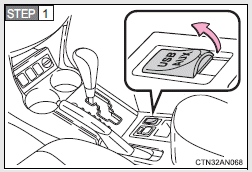
Open the cover and connect an iPod using an iPod cable. Turn on the power of the iPod if it is not turned on.
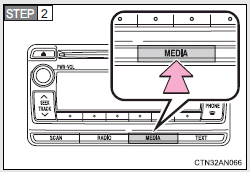
Press  .
.
■ Control panel

Selecting a play mode
1 Press  (MENU) to select iPod
menu mode.
(MENU) to select iPod
menu mode.
2 Turning  clockwise changes the
play mode in the following
order:
clockwise changes the
play mode in the following
order:
“Playlists”→“Artists”→“Albums”→“Songs”→“Podcasts”→“Genres” →“Composers”→“Audiobooks”
3 Press  to select the desired
play mode.
to select the desired
play mode.
■ Play mode list
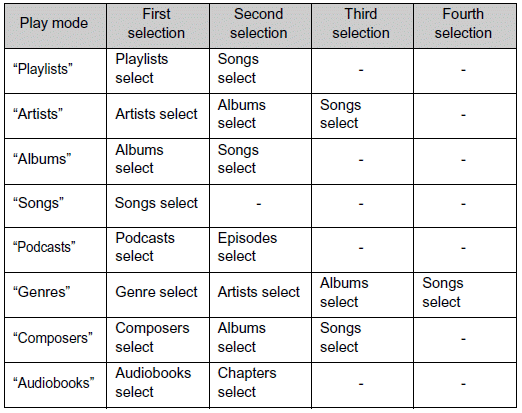
■ Selecting a list
1 Turn  to display the first
selection list.
to display the first
selection list.
2 Press  to select the
desired item.
to select the
desired item.
3 Pressing the knob changes to the second selection list.
Repeat the same procedure to select the desired item.
To return to the previous selection list, press
 (BACK).
(BACK).
Selecting songs
Turn  or press “∧” or “∨” on
or press “∧” or “∨” on
 to select the desired song.
to select the desired song.
Selecting a song from the song list
1 Press 
The song list will be displayed.
2 Turn 
to select a song.
3 Press  to play the song.
to play the song.
To return to the previous display, press
 (BACK).
(BACK).
Fast-forwarding and reversing songs
To fast-forward or reverse, press 
Shuffle playback
Pressing  (RDM) changes modes in
the following order:
(RDM) changes modes in
the following order:
Track shuffle → Album shuffle → Off
Repeat play
Press  (RPT).
To cancel, press
(RPT).
To cancel, press  (RPT) again.
(RPT) again.
Switching the display
Press  .
.
To return to the previous display, press
 or
or
 (BACK).
(BACK).
Adjusting sound quality and volume balance
1 Press  to enter iPod menu mode.
to enter iPod menu mode.
2 Press  changes sound modes.
changes sound modes.
About iPod
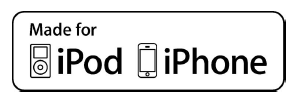
●“Made for iPod” and “Made for iPhone” mean that an electronic accessory
has been designed to connect specifically to iPod, or iPhone,
respectively, and has been certified by the developer to meet Apple performance
standards.
●Apple is not responsible for the operation of this device or its compliance
with safety and regulatory standards. Please note that the use of this
accessory with iPod or iPhone may affect wireless performance.
●iPhone, iPod, iPod classic, iPod nano and iPod touch are trademarks of
Apple Inc., registered in the U.S. and other countries.
■iPod functions
●When an iPod is connected and the audio source is changed to iPod
mode, the iPod will resume play from the same point in which it was last
used.
●Depending on the iPod that is connected to the system, certain functions
may not be available. If a function is unavailable due to a malfunction (as
opposed to a system specification), disconnecting the device and reconnecting
it once again may resolve the problem.
●While connected to the system, the iPod cannot be operated with its own
controls. It is necessary to use the controls of the vehicle’s audio system
instead.
■iPod problems
To resolve most problems encountered when using your iPod, disconnect your iPod from the vehicle iPod connection and reset it. For instructions on how to reset your iPod, refer to your iPod Owner’s Manual.
■Error messages
“iPod ERROR”: This indicates that the data in the iPod cannot be read.
“ERROR 3”: This indicates that the iPod may be malfunctioning.
“ERROR 4”: This indicates that an over current error has occurred.
“ERROR 5”: This indicates that an iPod communication error has
occurred.
“ERROR 6”: This indicates that an authentication error has occurred.
“NO SONGS”: This indicates that there is no music data in the iPod.
“NO PLAYLIST”: This indicates that some available songs are not found in
a selected playlist.
“UPDATE YOUR iPOD”: This indicates that the version of the iPod is not
compatible. Upgrade your iPod software to the latest
version.
■Compatible models
The following iPod®, iPod nano®, iPod classic®, iPod touch® and iPhone® devices can be used with this system.
●Made for
• iPod touch (4th generation)
• iPod touch (3rd generation)
• iPod touch (2nd generation)
• iPod touch (1st generation)
• iPod classic
• iPod with video
• iPod nano (6th generation)
• iPod nano (5th generation)
• iPod nano (4th generation)
• iPod nano (3rd generation)
• iPod nano (2nd generation)
• iPod nano (1st generation)
• iPhone 4
• iPhone 3GS
• iPhone 3G
• iPhone
Depending on differences between models or software versions etc., some models might be incompatible with this system.
Items related to standards and limitations are as follows:
●Maximum number of lists in device: 9999
●Maximum number of songs in device: 65535
●Maximum number of songs per list: 65535
CAUTION
■Caution while driving
Do not connect iPod or operate the controls.
NOTICE
■To prevent damage to iPod
●Do not leave iPod in the vehicle. The temperature inside the vehicle may
become high, resulting in damage to the iPod.
●Do not push down on or apply unnecessary pressure to the iPod while it is
connected as this may damage the iPod or its terminal.
●Do not insert foreign objects into the port as this may damage the iPod or
its terminal.
Operating a USB memory
Connecting a USB memory enables you to enjoy music from the vehicle speakers.
■ Connecting a USB memory
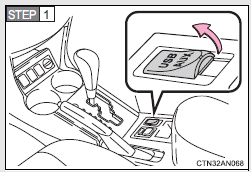
Open the cover and connect a USB memory. Turn on the power of the USB memory if it is not turned on.
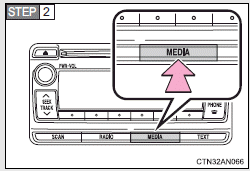
Press  .
.
■ Control panel
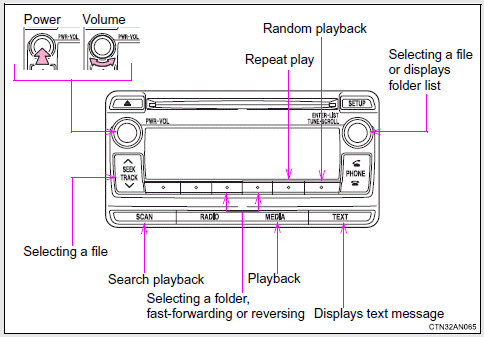
Selecting a folder
■ Selecting folders one at a time
To select the desired folder, press

■ Selecting a folder and file from folder list
1 Press  .
.
The folder list will be displayed.
2 Turn and press  to
select a folder and a file.
to
select a folder and a file.
To return to the previous display, press
 (BACK).
(BACK).
■ Returning to the first folder
Press and hold  (< ) until you
hear a beep.
(< ) until you
hear a beep.
Scanning a folder
1 Press and hold  until you hear
a beep.
The first 10 seconds of the first file in the each folder will be played.
until you hear
a beep.
The first 10 seconds of the first file in the each folder will be played.
2 When the desired folder is reached, press
 again.
again.
Selecting files
Turn  , or press “∧” or “∨” on
, or press “∧” or “∨” on
 to select the desired file.
to select the desired file.
Scanning files
1 Press  .
.
The first 10 seconds of all files in the folder will be played.
2 When the desired folder is reached, press
 again.
again.
Random playback
Pressing  (RDM) changes modes in
the following order:
(RDM) changes modes in
the following order:
Folder random → Disc random → Off
Repeat play
Pressing  (RPT) changes modes in
the following order:
(RPT) changes modes in
the following order:
File repeat → Folder repeat* → Off *: Available except when RDM (random playback) is selected
Switching the display
Press  .
Track title, Artist name and Album title (MP3 only) are shown on the display.
To return to the previous display, press
.
Track title, Artist name and Album title (MP3 only) are shown on the display.
To return to the previous display, press
 or
or
 (BACK).
(BACK).
■USB memory functions
●Depending on the USB memory that is connected to the system, the
device itself may not be operable and certain functions may not be available.
If the device is inoperable or a function is unavailable due to a malfunction
(as opposed to a system specification), disconnecting the device
and reconnecting it once again may resolve the problem.
●If the USB memory still does not begin operation after being disconnected
and reconnected, format the memory.
■Error messages
ERROR”: This indicates a problem in the USB memory or its connection.
“NO MUSIC”: This indicates that no MP3/WMA files are included in the USB
memory.
■USB memory
●Compatible devices
USB memory that can be used for MP3 and WMA playback
●Compatible device formats
The following device formats can be used:
• USB communication formats: USB2.0 FS (12 Mbps)
• File formats: FAT12/16/32 (Windows)
• Correspondence class: Mass storage class
MP3 and WMA files written in any format other than those listed above may not play correctly, and their file names and folder names may not be displayed correctly. Items related to standards and limitations are as follows:
• Maximum directory hierarchy: 8 levels
• Maximum number of folders in a device: 999 (including the root)
• Maximum number of files in a device: 9999
• Maximum number of files per folder: 255
●MP3 and WMA files
MP3 (MPEG Audio LAYER 3) is a standard audio compression format. Files can be compressed to approximately 1/10 of their original size using MP3 compression. WMA (Windows Media Audio) is a Microsoft audio compression format. This format compresses audio data to a size smaller than that of the MP3 format. There is a limit to the MP3 and WMA file standards that can be used and to the media/formats on which the files are recorded.
●MP3 file compatibility
• Compatible standards
MP3 (MPEG1 AUDIO LAYERIII, MPEG2 AUDIO LAYERIII, MPEG2.5)
• Compatible sampling frequencies
MPEG1 AUDIO LAYERII, III: 32, 44.1, 48 (kHz)
MPEG2 AUDIO LAYERII, III: 16, 22.05, 24 (kHz)
MPEG2.5: 8, 11.025, 12 (kHz)
• Compatible bit rates (compatible with VBR)
MPEG1 AUDIO LAYERII, III: 32-320 (kbps)
MPEG2 AUDIO LAYERII, III: 32-160 (kbps)
MPEG2.5: 8-160 (kbps)
• Compatible channel modes: stereo, joint stereo, dual channel and monaural
●WMA file compatibility
• Compatible standards
WMA Ver. 7, 8, 9
• Compatible sampling frequencies
HIGH PROFILE 32, 44.1, 48 (kHz)
• Compatible bit rates
HIGH PROFILE 48-320 (kbps, CBR)
●File names
The only files that can be recognized as MP3/WMA and played are those with the extension .mp3 or .wma.
●ID3 and WMA tags
ID3 tags can be added to MP3 files, making it possible to record the track title, artist name, etc. The system is compatible with ID3 Ver. 1.0, 1.1, and Ver. 2.2, 2.3, 2.4 ID3 tags. (The number of characters is based on ID3 Ver. 1.0 and 1.1.) WMA tags can be added to WMA files, making it possible to record the track title and artist name in the same way as with ID3 tags.
●MP3 and WMA playback
• When a device containing MP3 or WMA files is connected, all files in
the USB memory are checked. Once the file check is finished, the first
MP3 or WMA file is played. To make the file check finish more quickly,
we recommend that you do not include any files other than MP3 or
WMA files or create any unnecessary folders.
• When the USB memory is connected and the audio source is changed
to USB memory mode, the USB memory will start playing the first file in
the first folder. If the same device is removed and reinserted (and the
contents have not been changed), the USB memory will resume play
from the same point in which it was last used.
●Extensions
If the file extensions .mp3 and .wma are used for files other than MP3 and WMA files, they will be skipped (not played).
●Playback
• To play MP3 files with steady sound quality, we recommend a fixed bit
rate of at least 128 kbps and a sampling frequency of 44.1 kHz.
• There is a wide variety of freeware and other encoding software for
MP3 and WMA files on the market, and depending on the status of the
encoding and the file format, poor sound quality or noise at the start of
playback may result. In some cases, playback may not be possible at
all.
• Microsoft, Windows, and Windows Media are registered trademarks of
Microsoft Corporation in the U.S.A. and other countries.
CAUTION
■Caution while driving
Do not connect USB memory or operate the controls.
NOTICE
■To prevent damage to USB memory
●Do not leave USB memory in the vehicle. The temperature inside the vehicle
may become high, resulting in damage to the player.
●Do not push down on or apply unnecessary pressure to the USB memory
while it is connected as this may damage the USB memory or its terminal.
●Do not insert foreign objects into the port as this may damage the USB
memory or its terminal.
Optimal use of the audio system

Using the audio control function
■ Changing sound quality modes
1 Press  .
.
2 Turn  to select “Sound
Setting”.
to select “Sound
Setting”.
3 Press  .
.
4 Turn  to select the
desired mode.
to select the
desired mode.
“BASS”, “TREBLE”, “FADER”, “BALANCE”, or “ASL”
5 Press  .
.
■ Adjusting sound quality
Turning  adjusts the level.
adjusts the level.

*: The sound quality level is adjusted individually in each audio mode.
■ Adjusting the Automatic Sound Levelizer (ASL)
When ASL is selected, turning  to the right changes the
amount of “ASL” in the order of “LOW”, “MID” and “HIGH”.
to the right changes the
amount of “ASL” in the order of “LOW”, “MID” and “HIGH”.
Turning  to the left turns “ASL”
off.
to the left turns “ASL”
off.
ASL automatically adjusts the volume and tone quality according to vehicle speed.
Using the AUX port
This port can be used to connect a portable audio device and listen to it through the vehicle’s speakers.
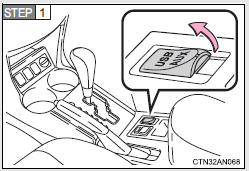
Open the cover and connect the portable audio device.
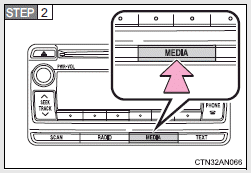
Press  .
.
■Operating portable audio devices connected to the audio system
The volume can be adjusted using the vehicle’s audio controls. All other adjustments must be made on the portable audio device itself.
■When using a portable audio device connected to the power outlet
Noise may occur during playback. Use the power source of the portable audio device.
Using the steering wheel audio switches
Some audio features can be controlled using the switches on the steering wheel.
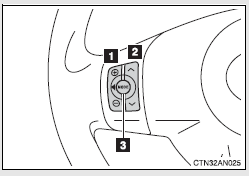
1 Volume
2 Radio mode: Select radio
stations
CD mode: Selects tracks
and files (MP3 and WMA)
iPod mode: Selects songs
USB memory mode:
Selects folders and files Bluetooth® audio mode:
Selects an album and tracks 3 Turns the power on, selects audio source
Turning on the power
Press  when the audio system is
turned off.
when the audio system is
turned off.
Changing the audio source
Press  when the audio system is
turned on. The audio source
changes each time
when the audio system is
turned on. The audio source
changes each time  is pressed. If a
mode cannot be used, it
will be skipped.
is pressed. If a
mode cannot be used, it
will be skipped.
Adjusting the volume
Press “+” on  to increase the
volume and “-” to decrease the volume.
to increase the
volume and “-” to decrease the volume.
Press and hold  to continue
increasing or decreasing the volume.
to continue
increasing or decreasing the volume.
Silencing a sound
Press and hold  .
.
To cancel, press and hold  again.
again.
Selecting a radio station
1 Press  to select the radio
mode.
to select the radio
mode.
2 Press “∧” or “∨” on  to select
a preset station.
to select
a preset station.
To scan for receivable stations, press and hold
 until you hear a
beep.
until you hear a
beep.
Selecting a track/file or song
1 Press  to select CD, iPod, USB
memory or Bluetooth®
audio mode.
to select CD, iPod, USB
memory or Bluetooth®
audio mode.
2 Press “∧” or “∨” on  to select
the desired track/file or
song.
to select
the desired track/file or
song.
Selecting a folder or album
1 Press  to select CD, USB
memory or Bluetooth® audio
mode.
2 Press and hold “∧” or “∨” on
to select CD, USB
memory or Bluetooth® audio
mode.
2 Press and hold “∧” or “∨” on  until you hear a beep.
until you hear a beep.
CAUTION
■To reduce the risk of an accident
Exercise care when operating the audio switches on the steering wheel.
Bluetooth® audio/phone
■ Bluetooth® audio
The Bluetooth® audio system enables you to enjoy music played on a portable digital audio player (portable player) from the vehicle speakers via wireless communication. This audio system supports Bluetooth®, a wireless data system capable of playing portable audio music without cables. If your portable player does not support Bluetooth®, the Bluetooth® audio system will not function.
■ Bluetooth® phone (hands-free phone system)
This system supports Bluetooth®, which allows you to make or receive calls without using cables to connect a cellular phone and the system, and without operating the cellular phone.
■Conditions affecting operation
The Bluetooth® audio/phone may not operate normally in the following situations:
●The portable player does not support Bluetooth®
●The cellular phone is located outside the service area
●The Bluetooth® device is switched off
●The Bluetooth® device has a low battery
●The Bluetooth® device is not connected to the system
●The Bluetooth® device is behind the seat or in the glove box or console
box, or metal material covers or touches the device
■When transferring ownership of the vehicle
Be sure to initialize the system to prevent personal data from being improperly accessed.
■About Bluetooth®

Bluetooth is a registered trademark of Bluetooth SIG. Inc.
■Compatible models
●Bluetooth® specifications:
Ver. 1.1, or higher (recommended: Ver. 2.1 + EDR or higher)
●Following Profiles:
• A2DP (Advanced Audio Distribution Profile) Ver. 1.0, or higher (recommended:
Ver. 1.2 or higher)
• AVRCP (Audio/Video Remote Control Profile) Ver. 1.0 or higher (recommended:
Ver. 1.3 or higher)
Portable players must correspond to the above specifications in order to be connected to the Bluetooth® audio system. However, please note that some functions may be limited depending on the type of portable player.
●Cellular phone
• HFP (Hands Free Profile) Ver. 1.0 or higher (recommended: Ver. 1.5)
• OPP (Object Push Profile) Ver. 1.1
• PBAP (Phone Book Access Profile) Ver. 1.0
CAUTION
■Caution while driving
●Do not use a cellular phone.
●Do not connect Bluetooth® device or operate the controls.
NOTICE
■To prevent damage to Bluetooth® device
Do not leave Bluetooth® device in the vehicle. The temperature inside the
vehicle may become high, resulting in damage to the device.
Using the Bluetooth® audio/phone
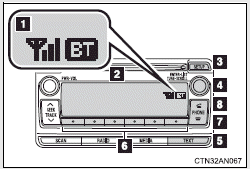
1 Bluetooth® connection condition
If “BT” is not displayed, the
Bluetooth® audio/phone
cannot be used.
2 Display
A message, name, number,
etc. is displayed.
Lower-case characters and special characters cannot be displayed.
3 Displays set up menu
4 Selects items such as menu
and number
Turn: Selects an item
Press: Inputs the selected
item
5 Displays information that is too long to be displayed at one time on the display (press and hold)
6 Selects speed dials
7 On-hook switch
Turns the hands-free system
off/ends a call/refuses a
call
8 Off-hook switch
Turns the hands-free system
on/starts a call
■ Microphone
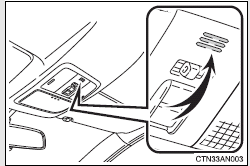
Using the Bluetooth® audio/phone for the first time
Before using the Bluetooth® audio/phone, it is necessary to register a Bluetooth® device in the system. Follow the procedure below to register (pair) a device:
1 Press and select “Bluetooth”
using
and select “Bluetooth”
using  .
.
2 Press  and select “Pairing”
using
and select “Pairing”
using  .
.
A passkey will be displayed.
3 SSP (Secure Simple Pairing) incompatible Bluetooth® devices: Input the passkey into the device. SSP (Secure Simple Pairing) compatible Bluetooth® devices:
Select “Yes” to register the device. Depending on the type of device, it may register automatically.
If a Bluetooth® device has both music player and cellular phone functions, both functions will be registered at the same time. When deleting the device, both functions will be deleted at the same time. If the off-hook switch is pressed and the “PHONE” mode is entered when no phones have been registered, the registration screen will be automatically displayed.
Menu list of the Bluetooth® audio/phone
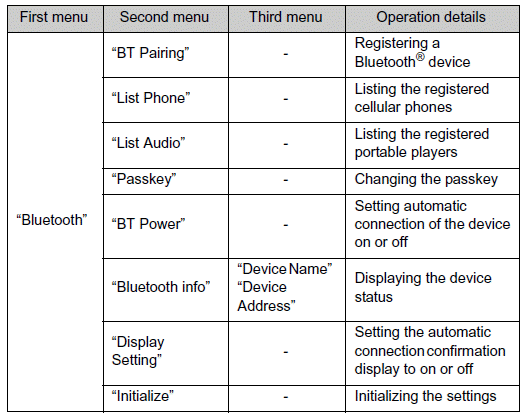
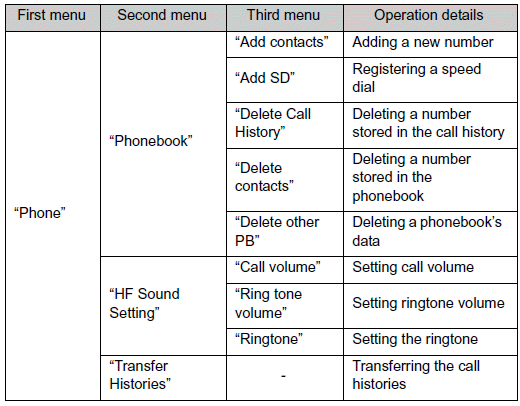
■Bluetooth® audio/phone system functions
Depending on the Bluetooth® device, certain functions may not be available.
Operating a Bluetooth® enabled portable player
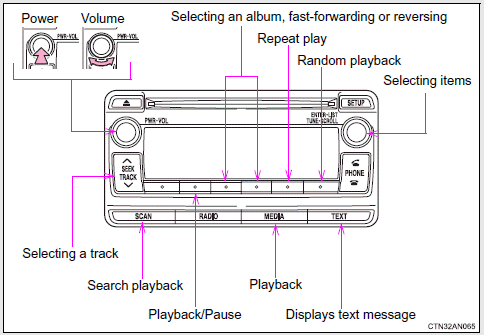
Selecting an album
Press  ( < ) or
( < ) or
 ( > ) to select the desired album.
( > ) to select the desired album.
Scanning an album
1 Press and hold  until you hear
a beep.
The first 10 seconds of the first track in the each album will be
played.
2 When the desired album is reached, press
until you hear
a beep.
The first 10 seconds of the first track in the each album will be
played.
2 When the desired album is reached, press
 again.
again.
Selecting tracks
Press “∧” or “∨” on  to select
the desired track.
to select
the desired track.
Scanning tracks
1 Press  .
.
The first 10 seconds of all tracks in the album will be played.
2 When the desired track is reached, press
 again.
again.
Playing and pausing tracks
Press  (
(
 ) to play or pause a track.
) to play or pause a track.
Random playback
Pressing  (RDM) changes modes in
the following order:
(RDM) changes modes in
the following order:
Album random → All track random → Off
Repeat play
Pressing  (RPT) changes modes in
the following order:
(RPT) changes modes in
the following order:
Track repeat → Album repeat* → Off
*: Available except when RDM (random playback) is selected
Switching the display
Press  .
.
Track title and Artist name are displayed on the display.
To return to the previous display, press
 or
or
 (BACK).
(BACK).
■Bluetooth® audio system functions
Depending on the portable player that is connected to the system, certain functions may not be available.
Making a phone call
To enter the “PHONE” mode, press the off-hook switch.
■ Making a phone call
● Dialing by selecting a name
● Speed dialing
● Dialing by entering the number
● Dialing from call histories
■ Receiving a phone call
● Answering the phone
● Refusing the call
■ Operations during a call
● Transferring a call
● Muting your voice
● Inputting digits
● Setting call volume
■ Adjusting the ringtone volume when receiving a call
Dialing by selecting a name
1 Select “Phonebook” using  .
.
2 Select the desired name using  and press the off-hook
switch.
and press the off-hook
switch.
By pressing  (Add S. Dial) and
one of the speed dial buttons
(from
(Add S. Dial) and
one of the speed dial buttons
(from  to
to
 ) while the desired name is
selected, it can be
registered as a speed dial.
) while the desired name is
selected, it can be
registered as a speed dial.
Speed dialing
1 Select “Speed dials” using  .
.
2 Press the desired preset button (from
 to
to
 ) and
press the off-hook switch
) and
press the off-hook switch
By pressing  (Add S. Dial) and
one of the speed dial buttons
(from
(Add S. Dial) and
one of the speed dial buttons
(from  to
to
 ) while the desired name is
selected, it can be
registered as a speed dial.
) while the desired name is
selected, it can be
registered as a speed dial.
Dialing by entering the number
1 Select “Dial by number” using  .
.
2 Enter the phone number and press the off-hook switch.
Dialing from call histories
1 Select “All calls”, “Missed calls”, “Incoming calls” or “Outgoing
calls” using  .
.
2 Select a desired number using and press the off-hook
switch.
and press the off-hook
switch.
The following operations can be performed:
● Registering a number as a speed dial
By pressing  (Add S. Dial) and
one of the speed dial buttons
(from
(Add S. Dial) and
one of the speed dial buttons
(from  to
to
 ).
).
● Deleting the selected number
Press  (DELETE) and press
(DELETE) and press
 (YES).
(YES).
When receiving a phone call
■ Answering the phone
Press the off-hook switch.
■ Refusing the call
Press the on-hook switch.
■ Receiving a call when on another call
Press the off-hook switch. Pressing the off-hook switch again returns you to the previous call.
Operations during a call
● Transferring a call
A call can be transferred between the cellular phone and system while dialing, receiving a call, or during a call. Use one of the following methods:
a. Operate the cellular phone.
Refer to the manual that comes with the cellular phone for the operation
of the phone.
b. Press the  * (PHONE).
*: This operation can be performed only when transferring a call from
the cellular phone to the system during a call.
* (PHONE).
*: This operation can be performed only when transferring a call from
the cellular phone to the system during a call.
● Muting your voice
Press  (MUTE).
(MUTE).
● Inputting digits
Press  (0-9) and using the
(0-9) and using the
 to input the desired digits.
to input the desired digits.
To send the input digits press  (SEND).
(SEND).
When finished, press  (EXIT) to
return to the previous screen.
(EXIT) to
return to the previous screen.
● Setting call volume
Change the call volume using  .
To decrease the volume: Turn
.
To decrease the volume: Turn  counterclockwise.
To increase the volume: Turn
counterclockwise.
To increase the volume: Turn  clockwise.
clockwise.
Adjusting the ringtone volume when receiving a call
Change the ringtone volume using  .
To decrease the volume: Turn
.
To decrease the volume: Turn  counterclockwise.
To increase the volume: Turn
counterclockwise.
To increase the volume: Turn  clockwise.
clockwise.
■When talking on the phone
●Do not talk simultaneously with the other party.
●Keep the volume of the received voice down. Otherwise, voice echo will
increase.
■Automatic volume adjustment
When vehicle speed is 50 mph (80 km/h) or more, the volume automatically increases. The volume returns to the previous volume setting when vehicle speed drops to 43 mph (70 km/h) or less.
■Phone call system functions
Depending on the cellular phone, certain functions may not be available.
■Situations where the system may not recognize your voice
●When driving on a rough road
●When driving at high speeds
●When air is blowing out of the vents onto the microphone
●When the air conditioning fan emits a loud noise
Using the “SET UP” menu (“Bluetooth” menu)
Registering a Bluetooth® device in the system allows the system to function. The following functions can be used for registered devices:
■ Functions and operation procedures
1 Press  and select “Bluetooth”
using
and select “Bluetooth”
using  .
.
2 Press  and select one of the
following functions
using
and select one of the
following functions
using  .
.
● Registering a Bluetooth® device
“BT Pairing”
● Listing the registered cellular phones
“List Phone”
● Listing the registered portable players
“List Audio”
● Changing the passkey
“Passkey”
● Setting automatic connection of the device on or off
“BT Power”
● Displaying the device status
“Bluetooth info”
● Setting the automatic connection confirmation display to on or
off
“Display Setting”
● Initialization
“Initialize”
Registering a portable player
Select “BT Pairing” using  , and
perform the procedure for registering
a portable player.
, and
perform the procedure for registering
a portable player.
Listing the registered cellular phones
Select “List Phone” using  . The
list of registered cellular
phones will be displayed.
. The
list of registered cellular
phones will be displayed.
● Connecting the registered cellular phone to the audio system
1 Select the name of the cellular phone to be connected
using  .
.
2 Select “Select” using  .
.
● Deleting a registered cellular phone
1 Select the name of the cellular phone to be deleted using
 .
.
2 Select “Delete” using  .
3 Press
.
3 Press  (YES).
(YES).
Listing the registered portable players
Select “List Audio” using  . The
list of registered portable players
will be displayed.
. The
list of registered portable players
will be displayed.
● Connecting the registered portable player to the audio system
1 Select the name of the portable player to be connected
using  .
.
2 Select “Select” using  .
.
● Deleting the registered portable player
1 Select the name of the portable player to be deleted using
 .
.
2 Select “Delete” using  .
.
3 Press  (YES).
(YES).
Changing the passkey
1 Select “Passkey” using  .
.
2 Select a 4 to 8-digit passkey using
 .
.
Input the number 1 digit at a time.
3 When the entire number to be registered as a passkey has
been input, press  again.
If the passkey to be registered has 8 digits, pressing
again.
If the passkey to be registered has 8 digits, pressing
 again
is not necessary.
again
is not necessary.
Setting automatic connection of the device on or off
If “BT Power” is set to on, the registered device will be connected automatically when the engine switch is turned to the “ACC” position.
1 Select “BT Power” using  .
.
2 Select “ON” or “OFF” using  .
.
Displaying the device status
Select “Bluetooth info” using  .
.
● Displaying the device name
Select “Device Name” using  .
.
● Displaying the device address
Select “Device Address” using  .
.
Setting the automatic connection confirmation display to on or off
If the “Display Setting” is set to on, the portable player connection status will be displayed when the engine switch is turned to the “ACC” or “ON” position.
1 Select “Display Setting” using  .
.
2 Select “ON” or “OFF” using  .
.
Initialization
Select “Initialize” using  .
.
● Initializing the sound settings
Select “Sound setting” using  and
press
and
press  (YES).
For details about sound settings
(YES).
For details about sound settings
● Initializing the device information
Select “Car Device Info” using  and press
and press  (YES).
(YES).
Automatic connection of a portable device, automatic connection confirmation display and the passkey will be initialized.
● Initializing the all settings
Select “All Initialize” using  and
press
and
press  (YES).
(YES).
■The number of Bluetooth® device that can be registered
Up to 5 Bluetooth® devices can be registered in the system.
Using the “SET UP” menu (“Phone” menu)
■ Functions and operation procedures
To enter the menu of each function, press
 and follow the steps below using
and follow the steps below using

● Adding a new phone number
1. “Phone” → 2. “Phonebook” → 3. “Add contacts”
● Setting speed dials
1. “Phone” → 2. “Phonebook” → 3. “Add SD”
● Deleting call histories
1. “Phone” → 2. “Phonebook” → 3. “Delete Call History”
● Deleting a registered phone number
1. “Phone” → 2. “Phonebook” → 3. “Delete contacts”
● Deleting another cellular phone’s phonebook
1. “Phone” → 2. “Phonebook” → 3. “Delete other PB”
● Setting call volume
1. “Phone” → 2. “HF Sound Setting” → 3. “Call Volume”
● Setting ringtone volume
1. “Phone” → 2. “HF Sound Setting” → 3. “Ringtone Volume”
● Setting ringtone
1. “Phone” → 2. “HF Sound Setting” → 3. “Ringtone”
● Transferring call histories
1. “Phone” → 2. “Transfer Histories”
Adding a new phone number
Select “Add contacts” using  .
.
● Transferring all contacts from the cellular phone
Select “Overwrite all contacts” using
 and press
and press
 (YES).
(YES).
● Transferring one contact from the cellular phone
Select “Add one contact” using  and
press
and
press  (YES).
(YES).
Setting speed dials
1 Select “Add SD” using  .
.
2 Select the desired data using  .
.
3 Press and hold the desired preset button (from
 to
to
 ).
).
Deleting call histories
Select “Delete Call History” using
 .
.
● Deleting outgoing call history
1 Select “Outgoing Calls” using  .
.
2 Select the desired phone number using
 and press
and press
 (YES).
(YES).
To delete all outgoing call history data, press
 (ALL) and
then press
(ALL) and
then press  (YES).
(YES).
● Deleting incoming call history
1 Select “Incoming calls” using  .
.
2 Select the desired phone number using
 and press
and press
 (YES).
(YES).
To delete all outgoing call history data, press
 (ALL) and
then press
(ALL) and
then press  (YES).
(YES).
● Deleting missed call history
1 Select “Missed Calls” using  .
.
2 Select the desired phone number using
 and press
and press
 (YES).
(YES).
To delete all outgoing call history data, press
 (ALL) and
then press
(ALL) and
then press  (YES).
(YES).
● Deleting a number from all call histories (Outgoing calls, Incoming calls and Missed calls)
1 Select “All Calls” using  .
.
2 Select the desired phone number using
 and press
and press
 (YES).
(YES).
To delete call histories data, press
 (ALL) and
then press
(ALL) and
then press  (YES).
(YES).
Deleting a registered phone number
1 Select “Delete contacts” using  .
.
2 Select the desired phone number using
 and press
and press
 (YES).
(YES).
To delete all of the registered phone numbers, select “All delete”
using  and press
and press
 (YES).
(YES).
Deleting another cellular phone’s phonebook
1 Select “Delete other PB” using  .
.
2 Select the desired phonebook using
 and press
and press
 (YES).
(YES).
Setting call volume
1 Select “Call Volume” using  .
.
2 Change the call volume.
To decrease the volume: Turn  counterclockwise.
To increase the volume: Turn
counterclockwise.
To increase the volume: Turn  clockwise.
clockwise.
Setting ringtone volume
1 Select “Ringtone Volume” using  .
.
2 Change the ringtone volume.
To decrease the volume: Turn  counterclockwise.
To increase the volume: Turn
counterclockwise.
To increase the volume: Turn  clockwise.
clockwise.
Setting ringtone
1 Select “Ringtone” using  .
.
2 Using  select a ringtone (1 -
3). To set the selected
ringtone, press
select a ringtone (1 -
3). To set the selected
ringtone, press  .
.
Transferring call histories
Select “Transfer Histories” using
 and press
and press
 (YES).
(YES).
■Phone number
Up to 1000 names can be stored.
■Call history
Up to 10 numbers can be stored in each of the outgoing, incoming and
missed call history memories.
■Limitation of number of digits
A phone number that exceeds 24 digits cannot be registered.
See also:
Media Center 230 (REQ) — AM/FM Stereo Radio And 6–Disc CD/DVD Changer (MP3/WMA
AUX Jack)
NOTE: The radio sales code is located on the lower right
side of the radio faceplate.
Media Center 230 (REQ) ...
Corrosion protection
Your SUBARU has been designed and
built to resist corrosion. Special materials
and protective finishes have been used on
most parts of the vehicle to help maintain
fine appearance, strength, and reliable
operation. ...

 Using the air conditioning system and defogger
Using the air conditioning system and defogger